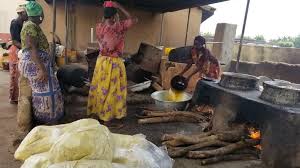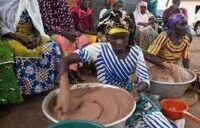Shea butter production is an integral part of the economy in Northern Ghana, particularly in Tamale. The production of unrefined organic shea butter plays a significant role in the livelihoods of many communities. The region’s abundant shea trees provide the raw nuts used to produce this natural butter.
Production of Shea Butter
Here is an overview of the process of making unrefined organic shea butter.
- Harvesting Shea Nuts
The process begins when workers collect shea fruits, typically harvested from May to August. The fruits fall naturally from the shea tree, and local women often gather them. Furthermore, workers de-pulp the fruit to reveal the nuts inside.
- Drying and Roasting the Nuts
Once workers extract the nuts, they spread them out to dry under the sun. This stage is crucial because improper drying can lead to poor-quality butter. After drying, workers roast the nuts in large clay or metal pots. The roasting process requires constant stirring to avoid burning the nuts, which would affect the final product’s flavour and quality.
- Crushing and Grinding
Furthermore, workers crush the roasted shea nuts into smaller pieces using traditional methods, such as pounding with a mortar and pestle. They then grind the crushed nuts into a thick paste using either hand tools or mechanical grinders, depending on the scale of production.

- Kneading and Extracting Butter
Workers then knead the ground paste by hand for several hours, periodically adding water to separate the fat from the solids. Moreover, this labour-intensive process requires skill and patience. As workers knead the paste, butterfat rises to the surface. They collect this fat and set it aside for further refinement.
- Boiling and Filtering
Workers boil the collected butterfat to remove any remaining impurities and water. Once boiling is complete, they filter the butter through a cloth or fine mesh to ensure its purity. This stage ensures that the final product is free from any particles or residues.
- Cooling and Packaging
After filtration, the shea butter is allowed to cool and solidify naturally. At this stage, the butter is creamy and ready for packaging. Since this is organic, no preservatives or additives are used, preserving its natural qualities.
This traditional craft not only contributes to the global demand for natural skincare products but also uplifts communities and preserves an ancient heritage in Tamale.
READ ALSO: Exploring the Best Agriculture Heritage of the Northern Region









[…] Read Also: 6 Quality Organic Shea Butter Production Process in Tamale […]